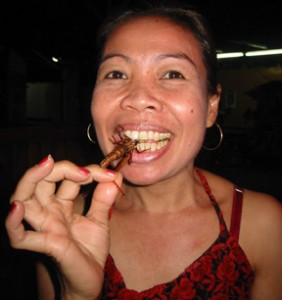Westerners visiting Thailand for the first time may quickly encounter a dramatic indicator that they’re no longer in the western world: the streetside bug cart. Loaded with trays filled with a number of delicious insect delights, these carts serve primarily Thai people who’ve emigrated to Bangkok from outlying provinces such as Isaan and the northern tribal areas, and who have made nutritious insects a part of their diet for generations.
The good news, for those of you willing to try eating a bug or two, is that you’re already doing it! It’s been estimated that, due to insects finding their way into processed food factories, the average westerner eats approximately a half pound of insects per year. According to the allowable levels of insects parts in the processed foods regulated by the United States Food and Drug administration, tomato sauce can contain 30 fly eggs per 100 grams of weight, a can of mushrooms is allowed to contain 24 mites, and chocolate may have up to 60 insect fragments per 100 grams.
The menu: what you’ll find on the bug cart
Typically, all carts will offer some or all of the following foods. Also note that non-insect delicacies, such as baby frog, may be on the cart as well. Your order will be placed in a sandwich-sized plastic bag, dosed with a shake or two of pepper, and quick spray of soy sauce. One shake of the bag, and it’s ready-to-eat.
Ant mix: ants mixed with vegetable and spices
Baby frog
Bamboo worm
Beetle (black)
Cicada
Cricket
Grasshopper
Mole Cricket
Scorpion (large, black)
Silkworm
Water Bug
The business end
Raising bugs can be good business for Thai farmers facing increasingly challenging environmental and financial concerns, namely the relative lack of irrigation water, and the significant costs associated with raising animals and crops, including fertilizers, pesticides, and feeds. Bugs can be raised in close quarters, require no veterinary care, and have a high feed-to-meat ratio.

Leave a Reply